Did you know that the Seychelles, an archipelago consisting of 115 granite and coral islands in the Indian Ocean, is home to an astonishing level of biodiversity? With an isolation period of 65 million years, this tropical paradise boasts unique flora and fauna that are found nowhere else on Earth.
The Seychelles is a hotspot for endemic species, with endemism rates ranging from 50-85% for different animal groups and approximately 45% for plants. In this paradise, you can discover 13 species and 17 subspecies of endemic birds, including the endangered Seychelles scops owl, black paradise flycatcher, and magpie robin. The only indigenous land mammals are bats, while the marine realm teems with 21 species of marine mammals.
However, this natural treasure is facing grave threats. Human activities, such as the introduction of invasive species, habitat destruction, pollution, and climate change, are pushing Seychelles’ biodiversity to the brink of extinction. To preserve this fragile ecosystem for future generations, urgent conservation efforts are crucial.
Key Takeaways:
- The Seychelles is an archipelago known for its exceptional biodiversity.
- Endemism rates in the Seychelles are remarkably high.
- The islands are home to endangered species, including endemic birds and marine mammals.
- Human activities pose severe threats to the Seychelles’ biodiversity.
- Conservation efforts are essential to protect and preserve Seychelles’ natural heritage.
Unique Plant Species in Seychelles
The Seychelles archipelago is renowned for its diverse and distinct plant life. With approximately 75 endemic plant species, the granitic islands and the Aldabra group serve as crucial habitats for these unique plants. Among them are several critically endangered species, including the captivating jellyfish tree, the beautiful Seychelles balsam, and the exquisite Wright’s gardenia.
A particular treasure of the Seychelles is the iconic Coco de Mer palm, known for its large double-lobed seed that resembles a female pelvis. This palm species is found exclusively on Praslin and Curieuse islands. The Coco de Mer is not only celebrated for its botanical rarity but also serves as a national flagship species for tourism and conservation efforts.
Another noteworthy endemic plant in Seychelles is the Vernonia seychellensis, a captivating flowering plant. This species, native to the islands, adds to the rich floral diversity of Seychelles. Preservation and protection of these endemic plant species are vital to maintaining the ecological balance and conserving the Seychelles’ natural heritage.
Endangered Bird Species in Seychelles
Seychelles is home to a remarkable variety of bird species, with a blend of land birds from Africa, Asia, and Madagascar. Among these avian treasures, there are 13 species and 17 subspecies of endemic birds found only in Seychelles. Unfortunately, some of these magnificent birds are endangered and require conservation efforts to ensure their survival.
Seychelles Black Parrot
One of the endangered bird species in Seychelles is the Seychelles black parrot. This unique parrot, known scientifically as Coracopsis (nigra) barklyi, is found exclusively on the islands of Praslin and Curieuse. Its distinct black plumage and vibrant red feathers make it a beloved symbol of Seychelles’ natural heritage. Efforts are underway to protect and increase the population of this exquisite bird.
Seychelles Magpie Robin
Another endangered bird species in Seychelles is the Seychelles magpie robin. With its striking black-and-white plumage and melodious song, this robin is a true gem of the archipelago. The scientific name for this bird is Copsychus sechellarum. Intensive conservation efforts, including translocation to different islands, have been successful in saving this species from the brink of extinction.
| Endangered Bird Species |
Scientific Name |
Conservation Status |
| Seychelles Black Parrot |
Coracopsis (nigra) barklyi |
Endangered |
| Seychelles Magpie Robin |
Copsychus sechellarum |
Endangered |
Seychelles Paradise Flycatcher
The Seychelles paradise flycatcher is another critically endangered bird species found only in Seychelles. With its graceful movements and vibrant plumage, this flycatcher, scientifically known as Terpsiphone corvina, is a sight to behold. Conservation efforts focus on protecting its habitat and increasing its population to prevent its extinction.
These endemic bird species are an integral part of Seychelles’ natural heritage and play a crucial role in the archipelago’s ecosystem. Protecting and conserving these unique birds not only preserves their beauty but ensures the overall health and balance of the Seychellois environment.
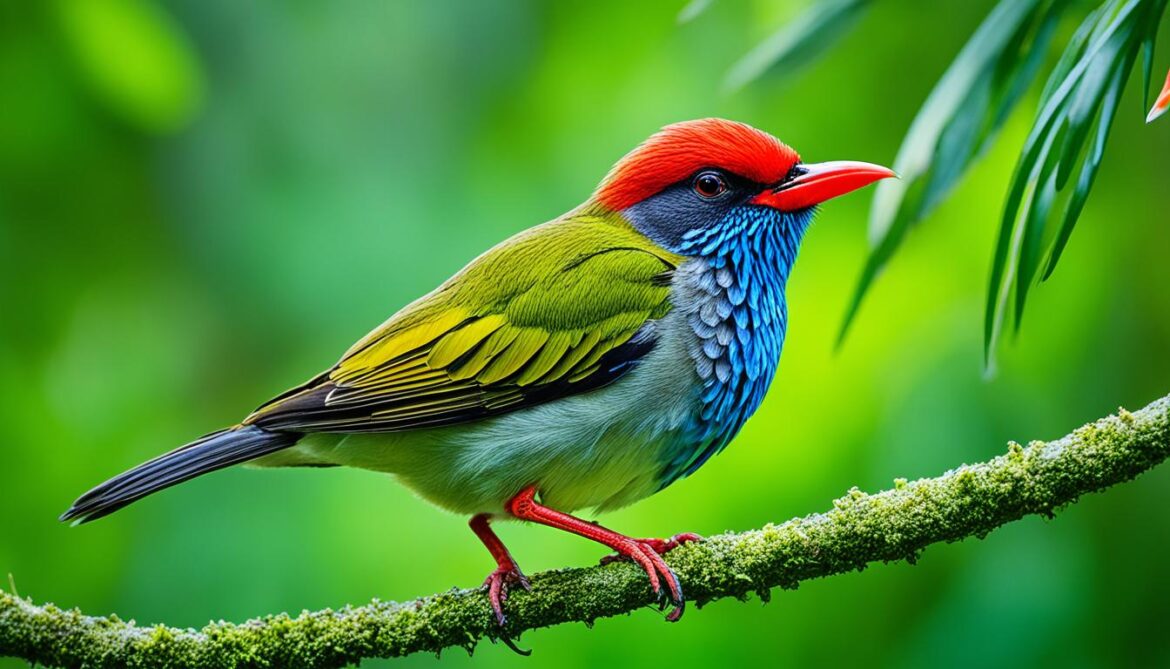
By working together and implementing conservation strategies, we can safeguard the Seychelles black parrot, Seychelles magpie robin, Seychelles paradise flycatcher, and other endemic bird species for future generations to admire and cherish.
Threatened Land and Marine Mammals in Seychelles
Seychelles is home to four endemic land mammal species, all of which are bats. The Seychelles sheath-tail bat is classified as critically endangered and is known to persist in only three roosts on Mahe and Silhouette islands. The Aldabra giant tortoise, introduced to many islands, is not considered endangered. Five turtle species occur in Seychelles, with the Hawksbill turtle being the most common nesting species and classified as endangered.
Endangered Bats: Seychelles Sheath-Tail Bat
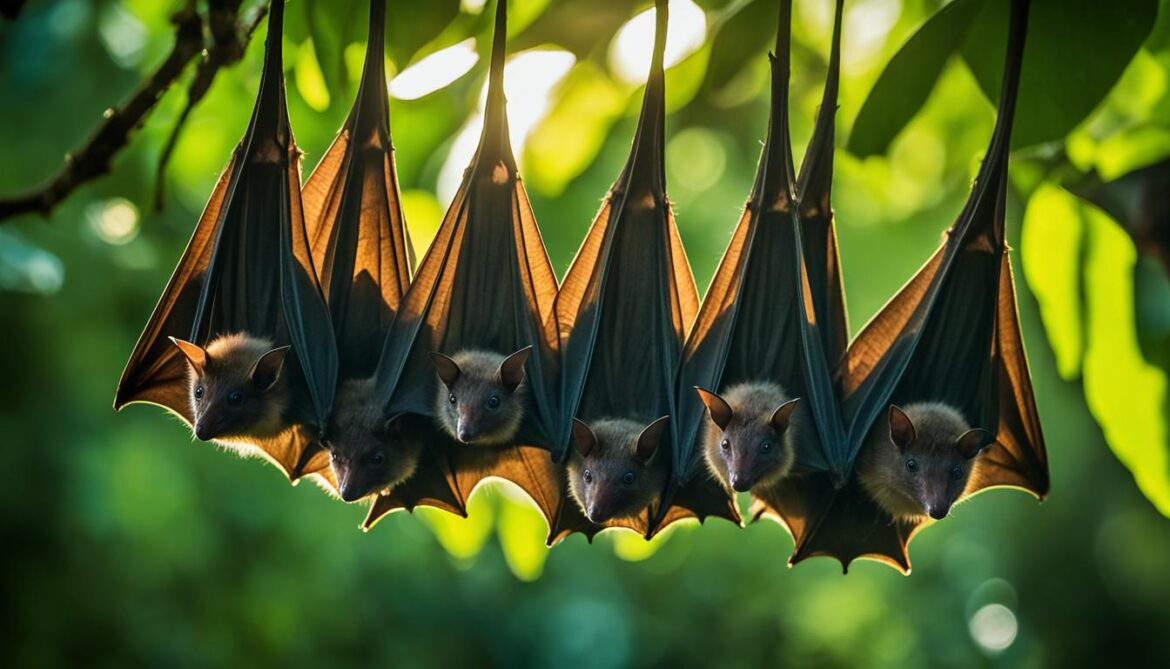
The Seychelles sheath-tail bat is a critically endangered species unique to Seychelles. Its population is currently limited to just three roosts on the islands of Mahe and Silhouette. Conservation efforts are in place to protect this rare and important bat species.
Protected Marine Species: Aldabra Giant Tortoise and Endangered Turtles
The Aldabra giant tortoise, although not native to Seychelles, has been introduced to several islands and is not considered endangered. With their impressive size and long lifespans, these tortoises are a fascinating sight for visitors.
| Turtle Species |
Status |
| Hawksbill Turtle |
Endangered |
| Green Turtle |
Endangered |
| Olive Ridley Turtle |
Endangered |
| Loggerhead Turtle |
Vulnerable |
| Leatherback Turtle |
Vulnerable |
Among the five turtle species found in Seychelles, the Hawksbill turtle is the most common nesting species and is listed as endangered. Conservation programs aim to protect these magnificent creatures and ensure their survival for future generations.
Vulnerable Amphibians and Marine Mammals in Seychelles
Seychelles is home to five endemic species of frogs and six endemic species of caecilians, both of which may be vulnerable to climate change and the introduction of viruses lethal to amphibians. These Seychelles endemic amphibians play a crucial role in the archipelago’s unique ecosystem, and their conservation is vital for maintaining the balance of biodiversity.
Among the Seychelles caecilians is the remarkable Seychelles caecilian (Gymnophiona seychellensis), characterized by its snake-like appearance. These legless amphibians dwell in the forested areas of the islands, relying on the moist soil for survival.
The marine environment surrounding Seychelles is also home to a diverse array of mammals. One notable species is the critically endangered Dugong, a large marine mammal closely related to the manatee. Seychelles is one of the few places in the world with a small breeding colony of Dugongs, particularly in the Aldabra lagoon.
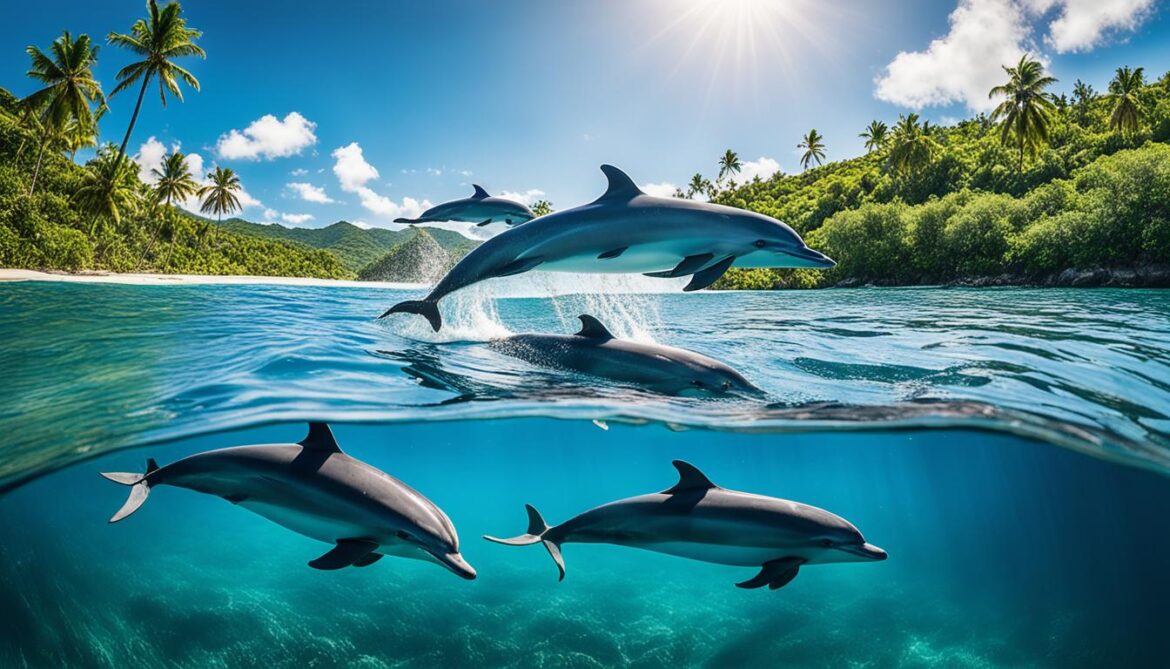
A dugong, one of the marine mammals found in Seychelles.
Conservation efforts focus on protecting the habitats of these vulnerable amphibians and marine mammals, as well as raising awareness about their importance in the ecological balance of Seychelles. Furthermore, continuous monitoring and research are essential to develop effective strategies for their long-term preservation.
Threats to Biodiversity in Seychelles
The Seychelles’ unique biodiversity is under threat from various factors that pose significant challenges to its conservation. The main threats include introduced species, habitat destruction and loss, anthropogenic activities, pollution, and siltation. Invasive alien species, such as rats and barn owls, further exacerbate the vulnerability of endemic species.
Habitat destruction and loss, driven by human activities such as coastal development and timber exploitation, are major contributors to the decline in biodiversity. The conversion of natural habitats for agricultural purposes and urbanization negatively impacts the delicate ecosystems that support Seychelles’ unique flora and fauna.
In addition to habitat destruction, invasive species pose a significant threat to the native species of Seychelles. Invasive alien species, such as rats and barn owls, compete for resources and prey on native species, leading to their decline or even extinction. These non-native species disrupt the delicate balance of the ecosystem and pose a long-term threat to Seychelles’ biodiversity.
Invasive alien species, habitat destruction, and coastal development are some of the biggest threats to Seychelles’ unique biodiversity.
Pollution, including oil spills and marine debris, has detrimental effects on marine ecosystems. The pollution of coastal areas, watersheds, and coral reefs negatively impacts the biodiversity of Seychelles. Siltation, caused by soil erosion and runoff from deforested areas, smothers coral reefs and affects the delicate balance of marine ecosystems.
Another pressing threat to Seychelles’ biodiversity is climate change, which manifests in the form of rising sea levels and coral bleaching events. Rising sea levels pose risks to coastal habitats and nesting grounds of marine species, leading to habitat loss and reduced breeding success. Coral bleaching, a consequence of rising sea temperatures, has devastating effects on coral reefs, affecting fish populations and reducing the overall biodiversity of marine ecosystems.
Threats to Biodiversity in Seychelles:
| Threat |
Description |
| Habitat Destruction and Loss |
Conversion of natural habitats for agricultural and urban development |
| Invasive Species |
Introduction of non-native species that compete with and prey on endemic species |
| Coastal Development |
Urbanization and infrastructural development along the coast, leading to habitat degradation |
| Pollution |
Oil spills, marine debris, and water pollution affecting marine ecosystems |
| Siltation |
Soil erosion and runoff causing sedimentation and smothering of coral reefs |
| Coral Bleaching |
Increasing sea temperatures leading to the loss of coral reef ecosystems |
The combination of these threats puts Seychelles’ unique biodiversity at risk. Efforts in conservation and sustainable management are crucial to mitigate these threats and protect the natural heritage of the islands.

Conservation Efforts in Seychelles
Seychelles has implemented extensive measures to enhance the conservation of its diverse biodiversity and uphold the principles of the Convention on Biological Diversity.
Conservation areas in Seychelles cover an impressive 47% of the country’s total surface area, encompassing protected terrestrial areas as well as reef and marine areas. These protected areas play a crucial role in safeguarding the unique and fragile ecosystems that exist within the Seychelles archipelago.

Among the renowned conservation sites in Seychelles is the Aldabra atoll, recognized as the largest raised atoll globally and designated as a UNESCO World Heritage Site. This remarkable site holds immense regional and global significance, providing a sanctuary for a diverse range of species, including rare and endemic animals and plants.
Species Translocation: Protecting and Expanding Endemic Bird Populations
Conservation efforts have included translocating endemic bird species between islands to bolster their populations and safeguard against local extinctions.
This species translocation initiative aims to increase the numbers of crucially endangered endemic bird species in Seychelles, helping to ensure their survival and contribute to the preservation of the country’s rich avian biodiversity.
Through strategic planning and careful implementation, Seychelles is working towards restoring and maintaining healthier bird populations throughout the archipelago.
The conservation efforts in Seychelles encompass not only protected areas and translocation initiatives but also focus on scientific research, education, and community engagement. These multifaceted approaches contribute to the overall success of biodiversity conservation in the country.
Implementation of the National Biodiversity Strategy and Action Plan (NBSAP)
The Republic of Seychelles has developed a National Biodiversity Strategy and Action Plan (NBSAP) to address the gaps identified in biodiversity conservation. The NBSAP outlines 11 major goals and includes 43 projects aimed at supporting the conservation and sustainable use of biodiversity, strengthening identification and monitoring processes, and promoting ex-situ conservation efforts.
The Government of Seychelles is actively working on harmonizing existing legislation into a comprehensive Biodiversity Act, which will provide a robust legal framework for biodiversity conservation. This legislation will help enforce the NBSAP’s objectives and ensure the effective protection of Seychelles’ unique biodiversity and natural heritage.
In addition to legislative measures, the government is implementing various initiatives to achieve the 2020 Aichi Biodiversity Targets. These targets, established under the Convention on Biological Diversity, are a set of strategic goals and actions to halt the loss of biodiversity and promote its sustainable use.
Through the NBSAP, Seychelles aims to:
- Promote the conservation of endemic and threatened species
- Protect and restore critical habitats
- Enhance sustainable management of natural resources
- Integrate biodiversity considerations into development planning
- Strengthen research and monitoring efforts
The NBSAP also emphasizes the importance of community engagement and capacity-building programs to ensure the active participation of local communities in biodiversity conservation. This inclusive approach fosters a sense of ownership and promotes the long-term sustainability of conservation projects in Seychelles.
| Biodiversity Goals |
Key Objectives |
| Goal 1: Protect and conserve endemic and threatened species |
1.1 Establish and manage protected areas
1.2 Implement species recovery plans |
| Goal 2: Safeguard critical habitats |
2.1 Strengthen marine and coastal protection
2.2 Restore degraded habitats |
| Goal 3: Foster sustainable use of natural resources |
3.1 Develop sustainable fisheries management systems
3.2 Promote sustainable agriculture and forestry practices |
| Goal 4: Integrate biodiversity into development planning |
4.1 Include biodiversity considerations in national policies and plans
4.2 Promote sustainable tourism practices |
| Goal 5: Enhance research and monitoring efforts |
5.1 Expand biodiversity research programs
5.2 Strengthen monitoring and data collection systems |
By implementing the NBSAP and working towards these goals, Seychelles is taking significant strides in conserving its precious biodiversity and ensuring its sustainable future.
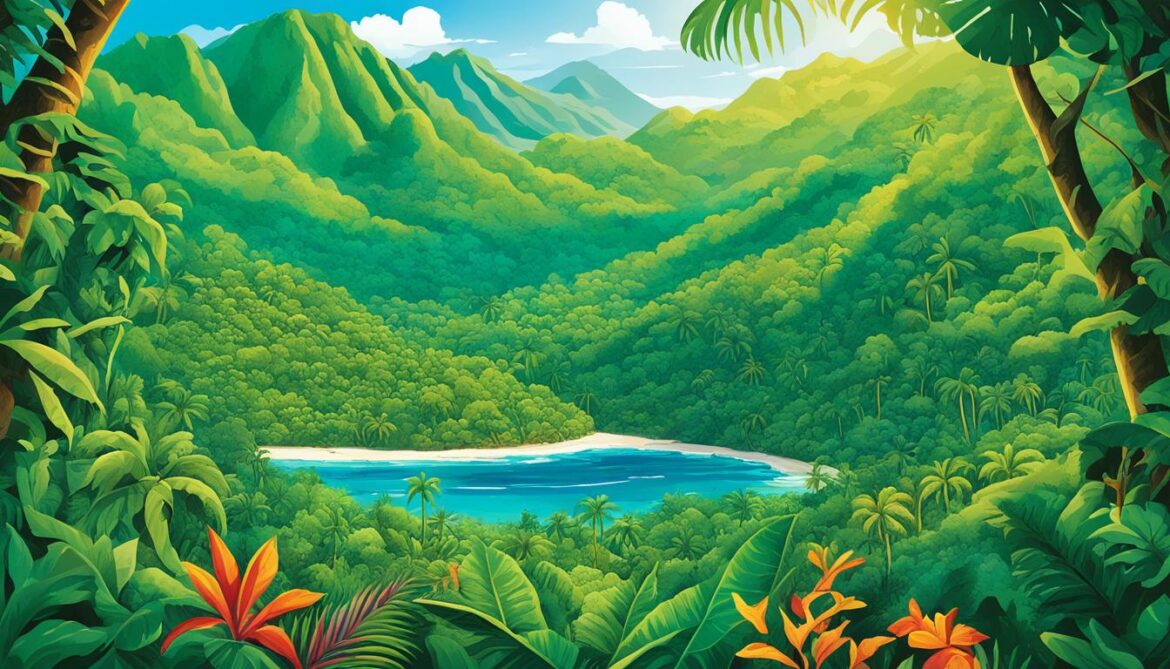
Testimonial from Dr. Marie Roberts, Conservation Scientist:
“The National Biodiversity Strategy and Action Plan is a comprehensive and strategic roadmap for biodiversity conservation in Seychelles. It sets clear goals and targets, and outlines practical projects that will make a real difference in protecting the unique flora and fauna of the islands. The joined efforts of the government, local communities, and conservation organizations pave the way for a brighter future for Seychelles’ natural heritage.”
Support Mechanisms for Biodiversity Conservation in Seychelles
In order to ensure effective implementation of biodiversity conservation in Seychelles, various support mechanisms have been established. These mechanisms play a crucial role in coordinating efforts and mainstreaming conservation practices across the country.
One of the key support mechanisms is the Environment Management Plan of Seychelles (EMPS), which provides guidelines and strategies for natural resource management and biodiversity conservation. The EMPS helps to integrate sustainable practices into development projects and ensures that environmental considerations are taken into account.
The Town and Country Planning Act is another important legislation that supports biodiversity conservation in Seychelles. This act provides a framework for land-use planning and ensures that development activities are carried out in an environmentally sustainable manner. It helps in protecting critical habitats and wildlife corridors, while also promoting sustainable development practices.
The Environment Protection Act is yet another legislation that plays a significant role in conserving biodiversity. This act provides a legal framework for regulating and controlling activities that may have adverse impacts on the environment. It helps in ensuring that environmental standards are met and that actions detrimental to biodiversity are avoided or minimized.
In addition to these legislations, Seychelles has received grants and implemented projects aimed at mainstreaming biodiversity management. These initiatives focus on capacity-building and raising awareness among stakeholders about the importance of biodiversity conservation. By strengthening the protected area system and supporting research and monitoring efforts, Seychelles aims to enhance its capacity for effective conservation.
The government of Seychelles is also focused on developing a biodiversity policy that will inform legislation and guide future conservation efforts. This policy will outline the country’s strategic objectives and provide a roadmap for preserving its rich biodiversity for future generations.
Support Mechanisms for Biodiversity Conservation in Seychelles
| Support Mechanism |
Description |
| Environment Management Plan of Seychelles (EMPS) |
Guidelines and strategies for natural resource management and biodiversity conservation |
| Town and Country Planning Act |
Framework for land-use planning and environmentally sustainable development |
| Environment Protection Act |
Regulation and control of activities with potential environmental impacts |
| Grants and Projects |
Funding and initiatives aimed at mainstreaming biodiversity management |
| Biodiversity Policy |
Strategic objectives and roadmap for biodiversity conservation |
Image: An illustration representing the diverse wildlife of Seychelles
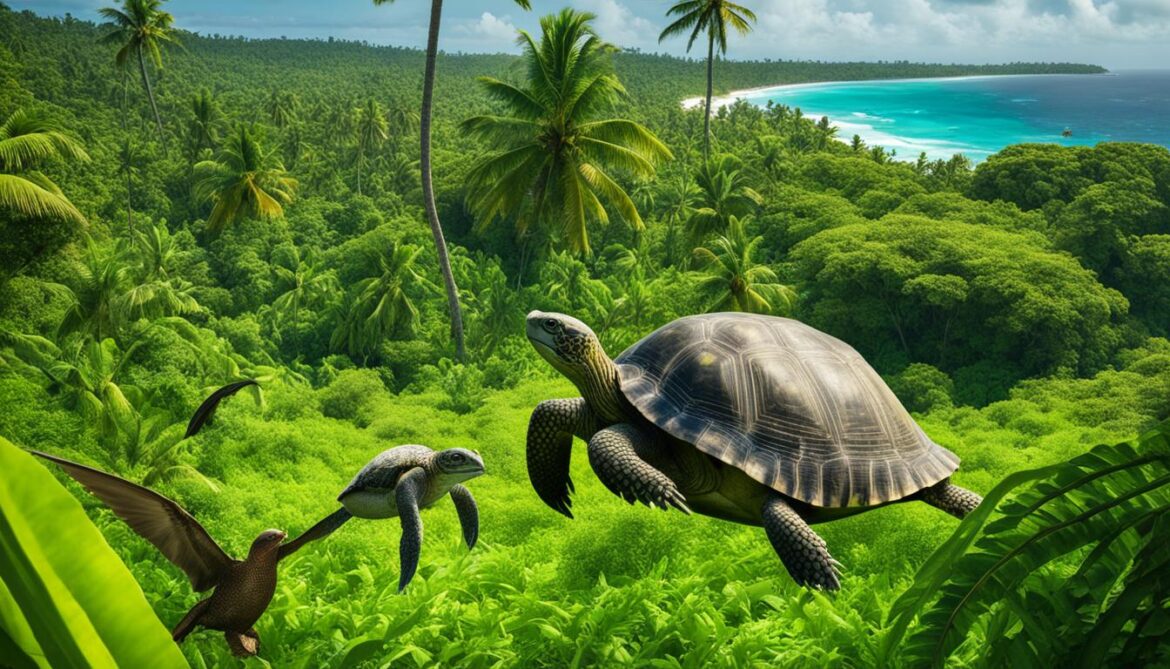
Conclusion
Seychelles faces numerous challenges in conserving its unique biodiversity, including habitat destruction, invasive species, and climate change. However, the country has implemented various conservation measures to tackle these issues and preserve its natural heritage.
The government’s commitment to biodiversity conservation is evident through the development of the National Biodiversity Strategy and Action Plan (NBSAP) and the drafting of legislation to protect wildlife. This comprehensive plan outlines the goals and objectives for sustainable biodiversity management in Seychelles, including the establishment of protected areas and the translocation of endemic species.
Despite the ongoing challenges, Seychelles remains dedicated to the preservation of its diverse ecosystem. Through continued efforts and scientific research, the future prospects for biodiversity conservation in Seychelles are promising. By promoting sustainable eco-tourism and working towards a harmonious balance between human activities and nature, Seychelles aims to secure its rich biodiversity for generations to come.
FAQ
What is the biodiversity like in Seychelles?
Seychelles is known for its unique biodiversity, with high levels of endemism. The archipelago is home to a wide range of animal and plant species, including endemic birds, bats, turtles, frogs, and caecilians.
What are some of the threatened plant species in Seychelles?
Some critically endangered plant species in Seychelles include the jellyfish tree, Seychelles balsam, and Wright’s gardenia. The famous Coco de Mer palm, found only on Praslin and Curieuse islands, is considered vulnerable.
Which bird species are endangered in Seychelles?
Endangered bird species in Seychelles include the Seychelles black parrot, Seychelles magpie robin, and Seychelles paradise flycatcher. Conservation efforts have focused on translocating these endemic birds between islands to protect against local extinctions.
What are the threatened land and marine mammals in Seychelles?
The only indigenous land mammals in Seychelles are bats, with the critically endangered Seychelles sheath-tail bat known to persist in only three roosts. The Aldabra giant tortoise, while introduced to many islands, is not considered endangered. Among marine mammals, the Dugong is critically endangered.
Are there any vulnerable amphibians and marine mammals in Seychelles?
Seychelles is home to five endemic species of frogs and six endemic species of caecilians, both of which may be vulnerable to climate change and the introduction of lethal viruses. Seychelles also has several species of marine mammals, including the critically endangered Dugong.
What are the main threats to biodiversity in Seychelles?
The main threats to Seychelles’ biodiversity include introduced species, habitat destruction and loss, anthropogenic activities like fishing and timber exploitation, pollution, and siltation. Invasive alien species and coastal development, as well as climate change impacts like rising sea levels and coral bleaching, also pose significant challenges.
What conservation efforts are in place in Seychelles?
Seychelles has implemented various measures to conserve its unique biodiversity, including the establishment of protected areas and translocation of endemic species. Conservation areas cover 47% of the country’s total surface area, and the Aldabra atoll is a UNESCO World Heritage Site.
What is the National Biodiversity Strategy and Action Plan (NBSAP) in Seychelles?
The NBSAP is a comprehensive plan developed by the Republic of Seychelles to support biodiversity conservation and sustainable use. It consists of 11 major goals and 43 projects aimed at strengthening identification, monitoring, and ex-situ conservation of biodiversity.
What support mechanisms are in place for biodiversity conservation in Seychelles?
Seychelles has established support mechanisms such as the Environment Management Plan, Town and Country Planning Act, and Environment Protection Act to implement biodiversity conservation. The country has also received grants and implemented projects to strengthen the protected area system and mainstream biodiversity management.
What are the challenges and prospects for biodiversity conservation in Seychelles?
Seychelles faces challenges such as habitat destruction, invasive species, and climate change impacts on its biodiversity. However, the country is committed to conservation efforts, as seen through the development of the National Biodiversity Strategy and Action Plan and the drafting of relevant legislation. With continued efforts and eco-tourism promotion, Seychelles aims to protect its natural heritage for generations to come.
Source Links






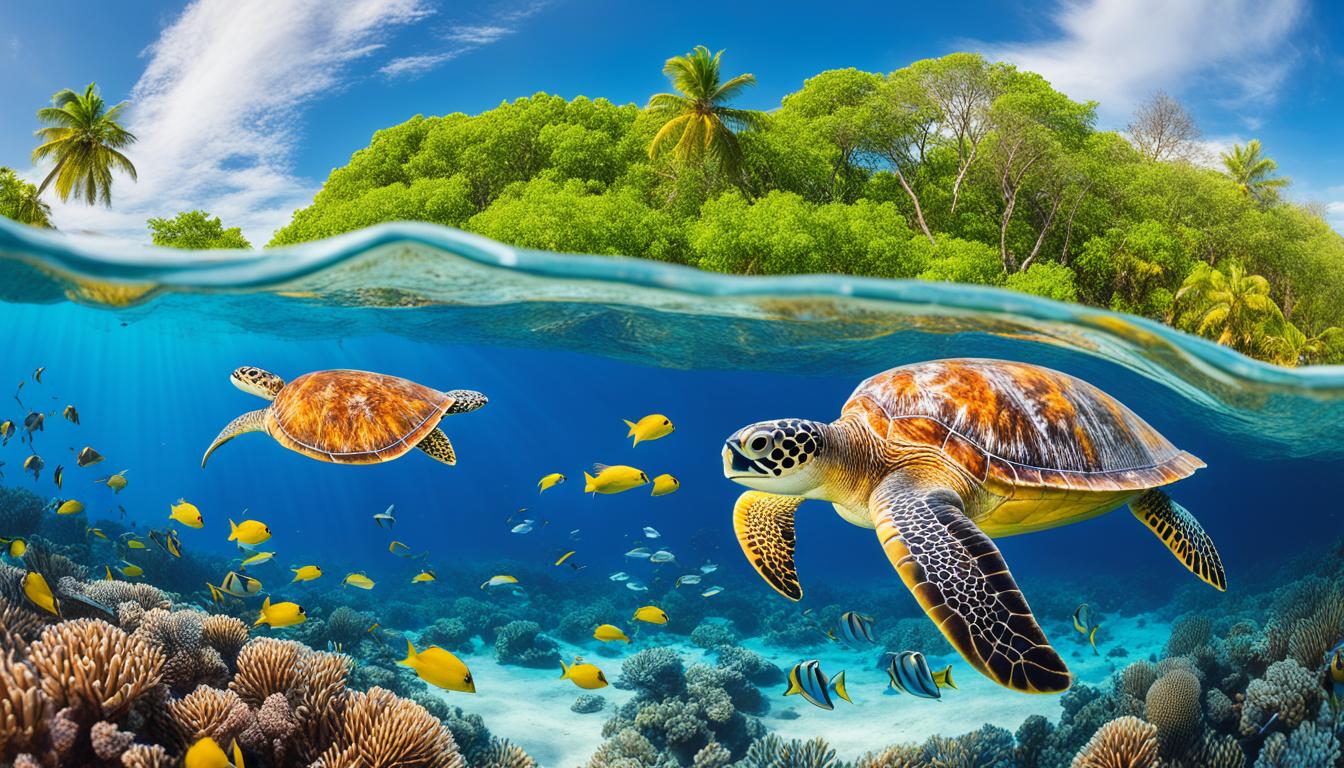







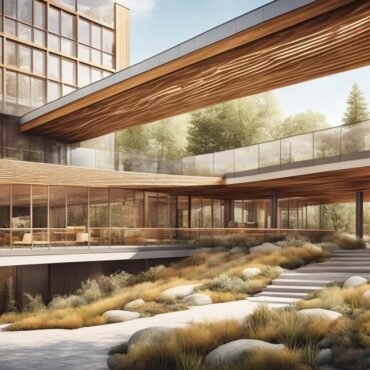










Post comments (0)